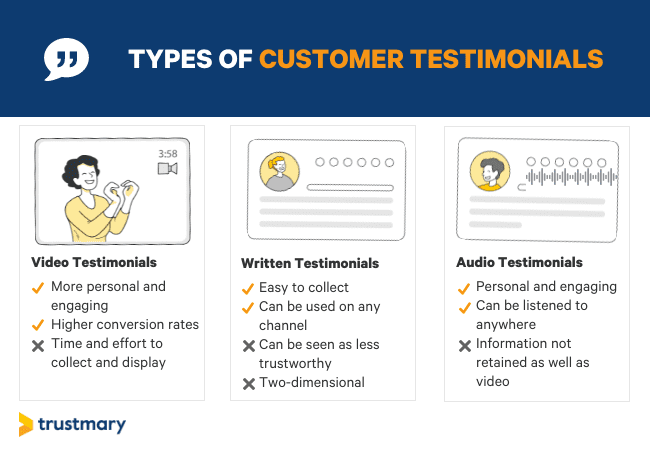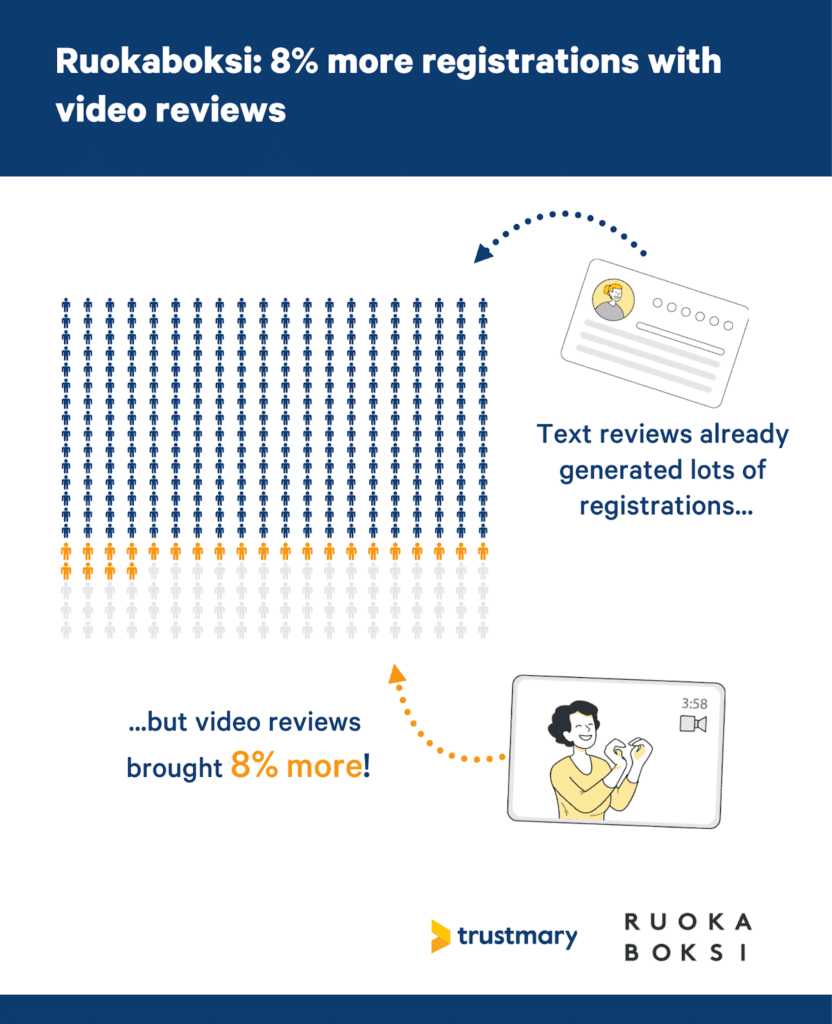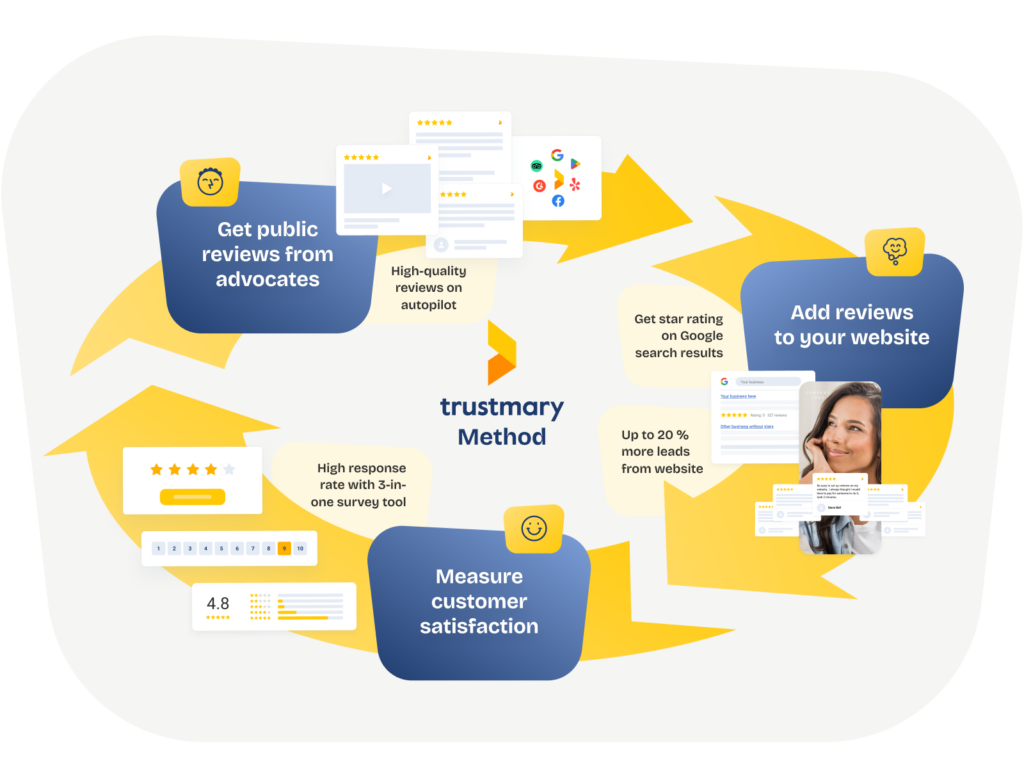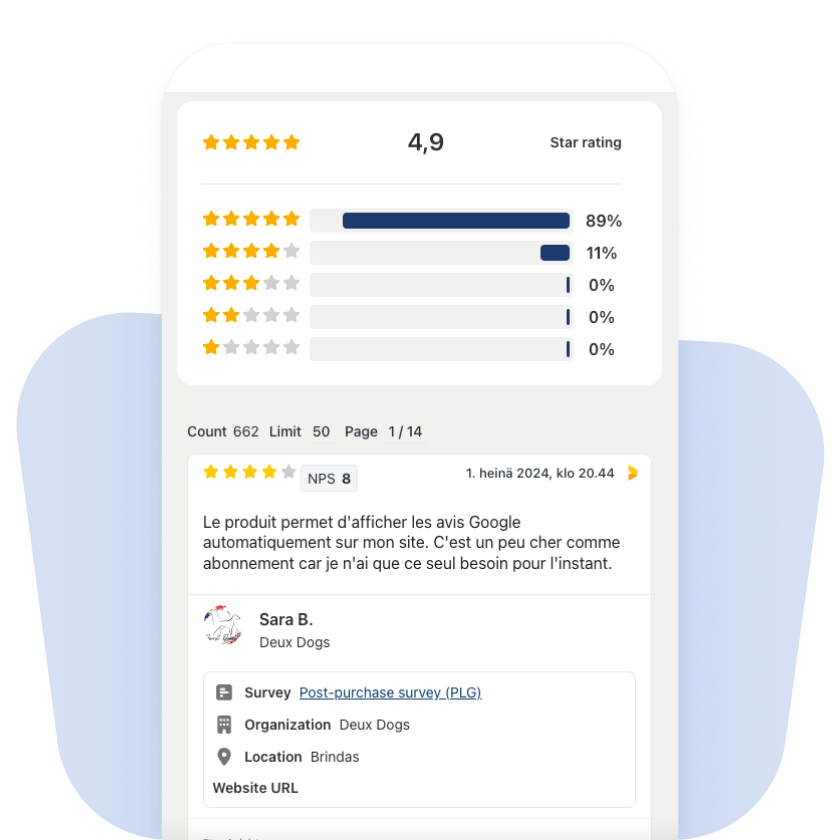How To Use Testimonials in Marketing

Have you ever had a friend recommend something to you?
A new restaurant, some face wash, an obscure band.
While their recommendation may fall out of your usual realm of comfort (anyone for some Folktronica?), how likely are you to give it a go?
Pretty likely, right?
The power of testimonials has increased massively in recent years as more and more people trust the word of others to validate their purchasing decision.
Where once we relied on feedback from our friends and families, now we’re increasingly turning to online reviews to provide that much needed social proof on just about anything. That is why review marketing is an essential part of today's marketing mix.
But unlocking the potential of a customer testimonial isn’t always as easy as it looks.
This article will walk you through everything you need to know about using testimonials for marketing. We’ll explore:
- Why testimonials are so effective
- How to collect customer testimonials for marketing
- How to use testimonials in your marketing efforts (with examples)
- A step-by-step guide to using customer testimonials
Why Are Testimonials Effective?
According to a study by Bright Local, 77% of consumers use reviews when browsing for local businesses in 2021, up 17% from 2020.
Customer testimonials and reviews are quickly becoming a firm fixture in marketing strategies, and not just in the B2C space.
92% of B2B buyers are more likely to purchase after reading a trusted review.
But why is a powerful review capable of influencing buying decisions?
Let’s take a look at some of the reasons:
Share Social Proof
A great testimonial is worth its weight in gold.
Why?
The key is in the nature of a good testimonial: a statement testifying to the quality of a product or service.
Literally, someone going on record to say how much they love what it is you do.
This is known as social proof.
Robert Cialdini, who studied social proof in-depth, said: “We view a behavior as more correct in a given situation to the degree that we see others performing it”.
Simply put - in an uncertain situation (do I really need to spend $800 on the latest smart watch on the market?) we assume that the people around us (our friends, experts, celebrities, anyone really, etc) have more knowledge, and so we look to them for confirmation on what should be done (“yes, you should most definitely buy that watch!”)
Build Trust in Your Products
Going back to my question at the start, why did you try something new based on a recommendation?
Because you trust your friend. Even if they have questionable taste in music.
The trust you have in them is transferred to what they recommend - I trust them, therefore I trust their judgment, therefore I have faith that this product will do what it says it does.
The same goes for customer testimonials.
If prospective customers see signs of happy customers, they are more likely to trust your product or service. In fact, 49% of respondents to the BrightLocal survey said they trust consumer reviews as much as personal recommendations from friends and family.
This is a great way for new companies to build trust in their relatively unheard of product or service.
In fact, 77% of people are likely to leave reviews if they know a business is fairly new.
Spread Positive Word of Mouth
Word of mouth generates twice the number of sales than paid ads, yet only 33% of businesses actively seek reviews and testimonials.
Word of mouth can make or break a company, but has largely been seen as a factor that brands have little control over.
Previously, a business would try its hardest to build an army of loyal customers with the hope that they would share their positive feedback with others.
But businesses have more agency than they realize.
You can’t force anyone to give you a good testimonial (no really, you absolutely shouldn’t do that), but you can, and really should, maximize what you do have.
A couple of great testimonials can be amplified across multiple channels, giving you more control over how you share the good word about your products or services.
How to Collect Customer Testimonials for Marketing
So how can you support your marketing efforts with great testimonials?
This is a no-brainer, really: by incorporating client testimonials into your marketing materials.
Here are 4 areas you should explore before getting started:
- What type of testimonials you should collect
- Who you should ask to provide testimonials
- When you should ask for testimonials
- How to ask for testimonials
1. What Type of Testimonials You Should Collect
Video Testimonials
The popularity of video content has increased massively in recent years. Conversion rates for video are also crazy high.
- Cisco reported that 82% of global internet traffic will come from video in 2022.
- 84% of marketers say video has helped them generate leads in a recent study by Wyzowl, and
- 78% of marketers said that video has directly increased sales.
It’s not hard to see why testimonial videos are so effective.
Video testimonials are more personal and engaging. What’s more, they get across important social cues such as emotions, gestures and facial expressions.
Studies show that after three days, your prospects will have retained an average of 65% of what they watched, compared to retaining 10% of what they only heard.
One downside of these kinds of customer testimonials could be the time and effort it takes to gather the feedback, edit and upload.
While this may be the case, the high engagement and conversion rates are worth the effort in the long run. For example, Ruokaboksi was able to get more registrations with video reviews.

Think of it this way:
- How valuable is one registration for your business?
- How much more revenue could you create, if you could increase your monthly conversion rate for registrations by 8%?
Let's take an imaginary situation, where your conversion for registrations is 75,4% when using text reviews. With video reviews, you could get that to 81,4%. Depending on your monthly traffic, the opportunities lost might be huuuuge.
When you factor in the value of each registration, you can start to see why you need to make sure you're losing as little opportunities as possible.
| Monthly traffic | Registrations with video reviews (81,4%) | Registrations with text reviews (75,4%) | Opportunities lost |
| 1.000 | 814 | 754 | 60 |
| 5.000 | 4070 | 3770 | 300 |
| 10.000 | 8140 | 7540 | 600 |
Try our tried and tested video testimonial questions to capture great video testimonials from customers!
Written Testimonials
The easiest to collect, a written testimonial can be submitted via a simple form or even in an email.
Written testimonials can be used in a variety of written marketing materials like your homepage, brochures and on social channels.
But while collecting and displaying written testimonials is easier, they are also easier to manipulate or fake.
Anonymized reviews in particular, are seen as less trustworthy - defeating the purpose of collecting and displaying the feedback in the first place!
Audio Testimonials
Much like video content, audio testimonials allow customers to tell their story in their own words.
Easy to record and share on your marketing channels, audio testimonials sit firmly in between written and video testimonials in terms of difficulty to collect and utilize for your purposes.
Audio testimonials are also easy for users to consume, as they can be listened to almost anywhere.

2. Who You Should Ask to Provide Testimonials
As testimonials are a statement of customer satisfaction, your existing customers will be the best source of positive feedback.
Your satisfied customers are more likely to want to provide a positive review or share their success stories - 67% will consider leaving a review after a positive experience.
Looking through your NPS data to find Promoters, or your sales data at how much money a customer spends, are good ways to identify your best customers.
Did you know you can use NPS in marketing?
3. When You Should Ask for Testimonials
As a rule, you’re more likely to get a positive testimonial if you ask when customer satisfaction is at its highest.
Consider your customer journey.
When do your customers feel most satisfied with your brand?
- When they’ve completed the sales process,
- When signing up for a repeat purchase or an upgrade,
- When referring your product or service to a friend or colleague.
Identifying these moments in the customer experience will give you clear touchpoints to engage with your target audience.
4. How to Ask for Testimonials
I’m going to let you in on a secret.
Not many people actually like asking for testimonials.
Some think it’s overstepping the mark. Others cringe at the idea, while many fear the customer saying no.
Luckily, we have some tips to help you ask for positive testimonials in a non-cringe inducing, boundary-pushing way, that’ll get you positive testimonials that you can use.
Set the Tone
Be clear, polite, friendly and firm. That might seem like alot but there’s really not much to it.
- Be clear about what you want from them.
- Be polite and friendly in the way you ask.
- Be firm in what you need and when you need it.
Here’s an example of how a request for a testimonial could look:
“Hey Marco,
I enjoyed working with you to get this deal over the line.
I wondered if you would be happy to provide a testimonial about your experiences that we can use when we’re talking to new customers about the service?
All I’d need is 20 minutes of your time to film you answering a few questions about how we worked together and what you loved about the service.
Would you be available on Friday to have a chat?
Thanks a lot.
Humaira”
Pro tip: Focus on creating a clear email subject line for your testimonial request. It should also be as personalized as possible!
Make it Easy
The easier it is for your client to provide feedback, the more likely that you are to get it.
A pop up after they’ve referred a friend, or a link to your testimonial page at the bottom of your email, helps to turn customer attention to giving a review when they are most satisfied.
It also shows them that you value their time.
Plus, prompt questions or examples of customer testimonials you’ve already got, can those who want to respond, but just don’t know how.
If you’re doing this by yourself, walk through the process and make sure it’s as friction-free as possible.
Alternatively there are plenty of helpful tools you can use to streamline the process.
For example, Trustmary’s helpful review widget can be set up in minutes to start collecting and incorporating testimonials to your website.
Close the Loop
Congratulations!
Your client has been kind enough to provide a glowing review. What’s your next step?
If you answered anything along the lines of ‘rush off to get it up on the website’, you’d be wrong, my friend.
The first thing you need to do is close the loop. Aka. respond to their positive reviews!
Thank your customer for their time, and their testimonial. Explain again that the testimonial will be used to support marketing activities, and make sure you have explicit consent.

WARNING: Customer Trust is Hard Won, But Easily Lost
UNDER NO CIRCUMSTANCES SHOULD YOU CREATE FAKE TESTIMONIALS FOR YOUR BRAND.
This is important so I’ll say it one more time. Fake reviews = bad.
A study from Gartner found that, “83% of consumers refuse to do business with brands they do not trust. To build trust, brands must focus on exhibiting transparency, warmth, honesty, and reliability.”
The moment that prospective customers find out that you’ve faked reviews, asked friends to create testimonials, or have even incentivized testimonials poorly, your credibility is shot.
You even risk causing longer lasting damage to your brand’s image.
Remember it’s quality, not quantity that counts.
Instead, maximize the impact of a few great testimonials to support your marketing strategy.
How To Use Testimonials in Marketing Materials (With Examples)
We’ve established the ground rules for collecting testimonials (absolutely no fake reviews!) but now let's look at how you can incorporate testimonials in your marketing strategy.
Website
As the digital shop window for your brand, your website is the natural place for customer testimonials to sit.
Several testimonials on your homepage can catch the reader’s eye.
You can even strategically select relevant testimonials or specific quotes to support your value proposition, or product benefits, and even reinforce purchasing decisions.
A well-timed pop up on service pages can help turn a prospective customer just window shopping into a qualified lead (one of our clients got 62% more leads), for example, or a testimonial on an event landing page can convert higher (the right testimonials can account for 8% more conversions).
Here’s an example of how Simba has built a page that displays different testimonials for each of its products:
Trustmary makes displaying testimonials on your website simple.
Case Studies
Longer form case studies tell a customer’s story of why and how they engaged with your brand, from start to finish.
A regular testimonial may just focus on the end result, or a specific point in the journey. A case study goes into much more detail about the problem the customer was having, the solution your business provided and the end result.
Case study testimonials are powerful marketing tools because they are so relatable.
The customer shares their story in their own words, but chances are other customers will share similar problems too.
Currencycloud uses case study testimonials to talk about their solution:
Social Media Marketing
The reach of social media makes it the perfect home for your customer testimonials.
Depending on the social media platform, written, video and audio work equally well to engage audiences and spread the word about your brand.
Relevant testimonials from existing customers can even be edited into bite-sized content to be used to support your social media marketing objectives.
A 5-second clip of customers talking about what they’d do if a new product is taken away could be used as a part of a Facebook ad campaign to appeal to the curiosity of potential customers, for example.
Here’s an example of how fitness brand Noom uses customer testimonials in their social media campaigns.
Email Marketing
Sharing testimonials via email is a great way to put good feedback directly into your customer’s inbox.
Crucially, most email marketing campaigns share testimonials with existing customers, or at least those who have opted in for marketing.
In this case, you may use the testimonials to upsell, or around the time a subscription is renewed to seal the deal.
For example, drip campaigns that introduce a new product and its benefits to a target audience, could be followed up by testimonials and other social proof.
Here’s an example of how Cladwell uses testimonials in it’s email marketing.
Other Marketing Materials
The beauty of testimonials is that once they’re collected, they can be used across any number of business-owned channels.
Creating print materials, like a brochure or a leaflet? Include a quote from your best customers
Building landing pages for a specific campaign? Add a video testimonial.
Delivering a sales pitch? Add a testimonial page to your presentation.
Paid advertisement in different channels? How about a testimonial ad?
Here’s how AirBnB used testimonials in its early pitch deck for investors:
Infact, the only limit to how you can use testimonials in marketing is your imagination.
I once met a guy at a conference who included a QR code to a video testi4.monial on his business card.
Ingenious!
But hang on a second...
You can also utilize testimonials to, wait for it, collect testimonials.
That’s right, sharing testimonials can lead to more testimonials.
People like being part of a crowd - remember the social proof science we mentioned earlier?

We look to others for behavior validation, so seeing customer testimonials with a request to share your own views is likely to strike a chord.
A Step-by-Step Guide to Using Customer Testimonials in Marketing
1. Identify Your Happy Customers
Use your business data to identify your most satisfied customers.
These may be your Promoters from your last NPS, those that have recently repurchased, or those who have proactively contacted you to tell you that they love what you do.
2. Find the Right Way to Request Customer Feedback
Think about the best way to approach your customer to ask for feedback. Perhaps you could bring it up during a regular call? Or maybe a simple email is enough. Or even a pop-up, triggered by a specific action on your site?
You could also check out one of the many great tools you can use to automate the process of requesting feedback.
3. Ask Your Customer
Now you know the right way to ask, don’t be shy. Ask your customer for their testimonial!
Don’t forget to be clear about what their feedback will be used for, and to get specific consent to use the testimonial for marketing when they provide it.
4. Organize Your Testimonials
Once you have a customer testimonial in hand, be organized about how you use it.
Keep track of who has provided feedback (including relevant information like where they are from, or their job title), the date, the product or service they are recommending, and where you’ve published it.
The latter is incredibly important so you can keep track of where and how you’ve used the testimonial for future reference.
5. Publish and Monitor
It’s time to publish your testimonial down your chosen channels.
Well done! You’ve successfully collected and displayed customer testimonials!
But your job isn’t done yet.
Keep an eye on how your testimonials are performing. For example, a particular testimonial may have a higher conversion rate with potential customers on your product and service pages.
6. Refresh and Repeat
“That testimonial was so last year.”
I wasn’t joking when I said your job wasn’t done yet. Customer testimonials age, and so it’s important that you keep refreshing them regularly.
The last thing you want is a video testimonial that refers to an out of date service, or quotes attributed to previous customers who have taken their business elsewhere.
Conclusion
The power that a testimonial has to support your marketing efforts is undeniable.
The influence that testimonials have on consumer purchasing decisions has been proven - for example, businesses with video testimonials convert better than those without.
Why?
Well, these words of endorsement, directly from your customers, provide social proof, help you build trust in your products and services, and spread positive word of mouth.
A positive testimonial can be used to support your marketing strategy across a multitude of marketing channels and materials.
They reinforce the messages that you want your customers to know about you, with the added credibility of coming from a customer.
Finding the right way to ask, organize and display your customer feedback is a fine art, however.
Luckily, tools like Trustmary’s review widget, take the effort out of using testimonials for marketing.
Additional Reading
The Definitive Guide for Understanding the Power of Social Proof
7 Tips For Using Customer Testimonial Videos in Marketing
How to Make a Testimonial Video? Top 5 Things to Consider
How to Add Testimonials to Website in Wordpress
How to Use Testimonials to Improve Website Conversion Rates for Lead Generation
FAQs
Are testimonials effective?
Customer testimonials are an incredibly effective way to provide social proof, help you build trust in your products and services, and spread positive word of mouth.
Infact, 77% of consumers use reviews when browsing for local businesses in 2021.
What are the different types of testimonials?
There are three different ways that you can capture a customer testimonial:
- Video testimonials
- Written testimonials
- Audio testimonials
What type of customers should I approach to give a testimonial?
You should be contacting your most loyal and satisfied customers for testimonials.
Look for NPS Promoters, customers with a high Customer Satisfaction score, or high engagement, for example.
Not only will they be more inclined to provide positive feedback, but they will have better success stories to share.
How should I ask for a testimonial?
- Identify the best time in the customer journey to request a testimonial
- Be clear about what you want from them, and what you’ll be using it for
- Make it easy to provide feedback
- Close the loop with customers who provide testimonials
Should I create fake testimonials?
Under no circumstances should you create fake testimonials. A false endorsement or review can result in distrust, and have a hugely negative impact on your brand’s image.
Instead, focus on amplifying the few good testimonials that you do have.
What’s the best way to display testimonials?
Testimonials are versatile and can be used across a number of different marketing channels to support your marketing strategy. Some of the most common ways to display testimonials are:
- Website home page
- Product and service pages
- Landing pages
- Case studies
- Social media channels
- Email marketing
- Print materials
